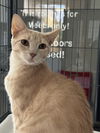Welcome to Pet Rescue By Judy!
401 South Laurel Avenue
Sanford, FL 32771
(407) 302-4497
info@petrescuebyjudy.com
Lulu The Basset Mama's Web Page
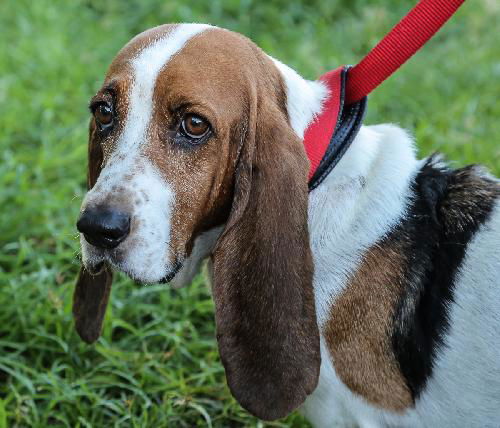
| My Rescue |
| Login to Remember your Favorite Animals and Breeds! |
Name: Lulu The Basset Mama
Status: Adopted!
Adoption Fee: 200.00
Species: Dog
Breed: Basset Hound (short coat)
Learn more about the Basset Hound.Pattern: Patches
Sex: Female (spayed)
Current Size: 40.8 Pounds
General Potential Size: Medium
Current Age: 15 Years 11 Months (best estimate)
Activity Level: Moderately Active
Indoor or Outdoor: Indoor Only
Good with Dogs: Yes
Microchipped: Yes
Lulu The Basset Mama's baby boy, Fisher the Basset Puppy (adopted) can also be seen on our website.
Lulu The Basset Mama's companion, Gator the Basset Daddy (adopted) can also be seen on our website.
Lulu The Basset Mama's companion, Gator the Basset Daddy (adopted) can also be seen on our website.
Description:
Lulu, her friend Gator, and their baby Fisher came from a kill shelter. The owner was moving and couldn't take the little family with him. Lulu is friendly toward other dogs, but she's happiest when she's playing with Gator. We would love for the two to be adopted together!
To keep the Basset Hound healthy, it should be given plenty of exercise, including a long daily walk to keep the dog mentally stable, but discourage it from jumping and stressing the front legs. This breed will run and play by the hour when given the chance. Because of their keen noses they tend to roam when they pick up a scent. Take care when off lead that the dog is in a safe area. Bassets like to do tricks for food. They have a deep musical bark. Housebreaking is difficult, but they do well with positive reinforcement and patient, gentle training. With proper training, they are obedient, but when they pick up an interesting smell, it's sometimes hard to get their attention, as they like to follow their noses and may not even hear you calling them back. Only allow your Basset off lead in safe areas.
According to www.dogbreedinfo.com, the name Basset Hound comes from the French word "bas" meaning low. Some sources suggest the Basset Hound may have originated from genetic dwarf dogs presented in litters of other types of French hunting hounds, however, we do know that it is a rather old breed, descended directly from the Bloodhound. Shakespeare described the Basset Hound with the following poetic image: "Ears which sweep away the morning due." According to research, the true fame of the Basset Hound began in 1863, when it was presented at the Paris Dog Show. Its popularity spread to England where a lively dispute arose between two factions of breeders: Those who wanted to keep the Basset Hound a hunting dog, and those who wanted to transform it into a companion dog. Situated between these two factions were the American breeders who proceeded to develop an extremely pleasing companion dog without sacrificing any of the qualities of the hunter. The breed was recognized by the American Kennel Club in 1885. Its natural bent is for hunting both in the den and in the open. It is therefore, used for the hunting of fox, hare, opossum, and pheasant. Bassets can hunt in packs or alone. It has an excellent sense of smell, but its reflexes are a bit slow. Their slow pace is convenient for hunters on foot and keeps game from being scared out of reach. The Basset's nose is almost as outstanding as the Bloodhound's. George Washington may have owned Basset Hounds given to him by Lafayette after the American Revolution. The Basset Hound is sweet, gentle, devoted, peaceful and naturally well-behaved. They fit into family life well. Their temperament should always be friendly with never an indication of sharpness or viciousness. They are mild but not timid; very affectionate with its master and friendly with children. It is incapable of biting, but it may be a bit stubborn. They like to do tricks for food. It has a deep musical bark. Housebreaking is difficult, but they do well with gentle patient training and positive reinforcement. With proper training, they are obedient, but when they pick up an interesting smell, it's sometimes hard to get their attention. They have a life expectancy of 10-12 years.
Lulu, her friend Gator, and their baby Fisher came from a kill shelter. The owner was moving and couldn't take the little family with him. Lulu is friendly toward other dogs, but she's happiest when she's playing with Gator. We would love for the two to be adopted together!
To keep the Basset Hound healthy, it should be given plenty of exercise, including a long daily walk to keep the dog mentally stable, but discourage it from jumping and stressing the front legs. This breed will run and play by the hour when given the chance. Because of their keen noses they tend to roam when they pick up a scent. Take care when off lead that the dog is in a safe area. Bassets like to do tricks for food. They have a deep musical bark. Housebreaking is difficult, but they do well with positive reinforcement and patient, gentle training. With proper training, they are obedient, but when they pick up an interesting smell, it's sometimes hard to get their attention, as they like to follow their noses and may not even hear you calling them back. Only allow your Basset off lead in safe areas.
According to www.dogbreedinfo.com, the name Basset Hound comes from the French word "bas" meaning low. Some sources suggest the Basset Hound may have originated from genetic dwarf dogs presented in litters of other types of French hunting hounds, however, we do know that it is a rather old breed, descended directly from the Bloodhound. Shakespeare described the Basset Hound with the following poetic image: "Ears which sweep away the morning due." According to research, the true fame of the Basset Hound began in 1863, when it was presented at the Paris Dog Show. Its popularity spread to England where a lively dispute arose between two factions of breeders: Those who wanted to keep the Basset Hound a hunting dog, and those who wanted to transform it into a companion dog. Situated between these two factions were the American breeders who proceeded to develop an extremely pleasing companion dog without sacrificing any of the qualities of the hunter. The breed was recognized by the American Kennel Club in 1885. Its natural bent is for hunting both in the den and in the open. It is therefore, used for the hunting of fox, hare, opossum, and pheasant. Bassets can hunt in packs or alone. It has an excellent sense of smell, but its reflexes are a bit slow. Their slow pace is convenient for hunters on foot and keeps game from being scared out of reach. The Basset's nose is almost as outstanding as the Bloodhound's. George Washington may have owned Basset Hounds given to him by Lafayette after the American Revolution. The Basset Hound is sweet, gentle, devoted, peaceful and naturally well-behaved. They fit into family life well. Their temperament should always be friendly with never an indication of sharpness or viciousness. They are mild but not timid; very affectionate with its master and friendly with children. It is incapable of biting, but it may be a bit stubborn. They like to do tricks for food. It has a deep musical bark. Housebreaking is difficult, but they do well with gentle patient training and positive reinforcement. With proper training, they are obedient, but when they pick up an interesting smell, it's sometimes hard to get their attention. They have a life expectancy of 10-12 years.
Other Pictures of Lulu The Basset Mama (click to see larger version):
 47.9k |
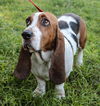 58.6k |
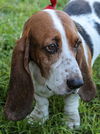 59.4k |
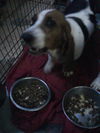 36.9k |
Copyright © Pet Rescue by Judy
